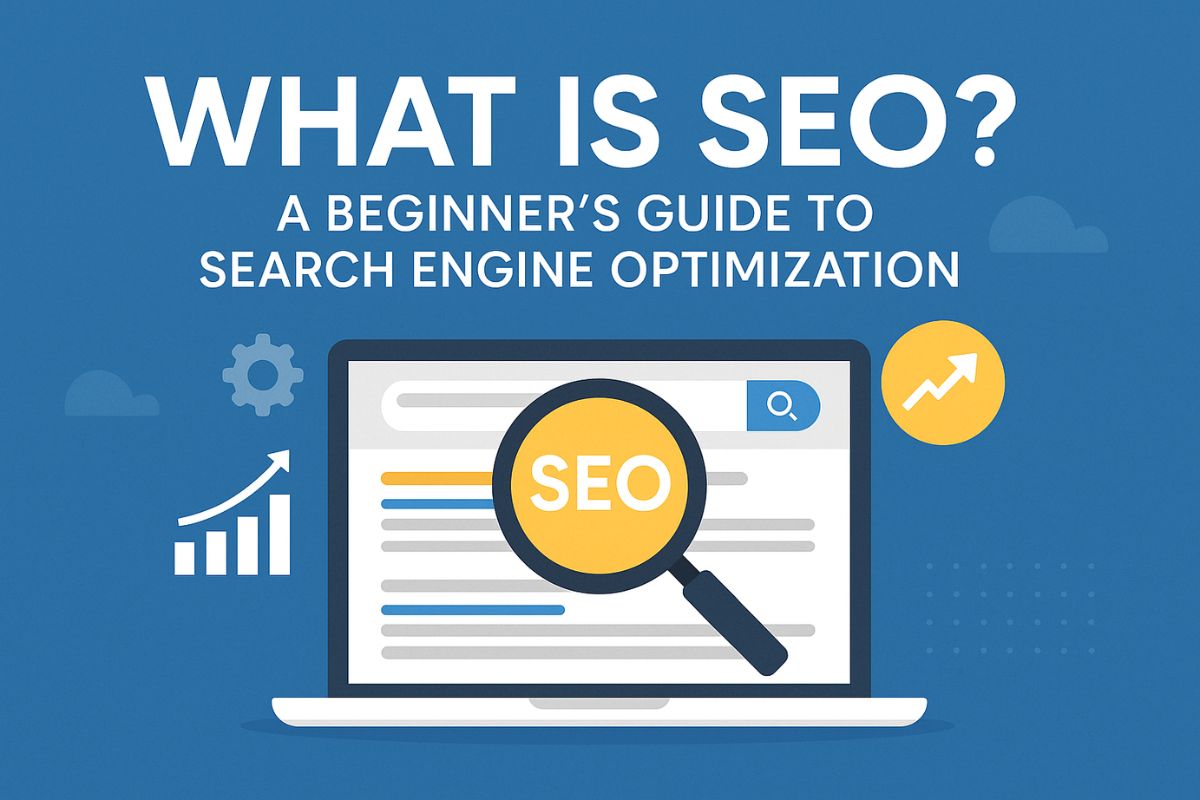What is SEO? SEO stands for Search Engine Optimization, a process of improving a website’s visibility on search engines like Google, Bing, and Yahoo. The goal is to rank higher in search results organically (without paid ads) to attract more visitors.
SEO is a crucial part of digital marketing because it helps businesses and bloggers reach their target audience effectively. Whether you’re running an online store, a blog, or a business website, understanding Search Engine Optimization can help you grow your online presence.
In this guide, we’ll break down SEO in simple terms, explain how it works, and share actionable tips to improve your rankings.
Why is SEO Important?
Here are a few reasons why SEO matters, especially for students:
- More Visibility: Higher rankings mean more people find your content.
- Cost-Effective: SEO brings free traffic compared to paid ads.
- Better User Experience: SEO includes improving your site’s usability.
- Builds Trust and Credibility: Users trust Google’s top results.
- Career Opportunities: SEO is a valuable skill in digital marketing.
Types of SEO
There are three main types of SEO. Each one focuses on a different area.
1. On-Page SEO
On-page SEO refers to optimizations done on your website, including:
Keyword optimization – Using relevant keywords naturally.
Content quality – Creating valuable, well-structured content.
Meta tags – Writing compelling titles and descriptions.
Internal linking – Connecting related pages within your site.
2. Off-Page SEO
Off-page SEO focuses on external factors, such as:
Backlinks – Getting links from high-authority sites.
Social signals – Shares and engagement on social media.
Brand mentions – Being referenced by other websites.
3. Technical SEO
Technical SEO ensures your website is crawlable and indexable by:
- Improving site speed
- Fixing broken links
- Using proper URL structures
- Implementing schema markup
How Does SEO Work?
Search engines use bots (called crawlers) to scan websites and rank them based on:
-
Relevance – Does your content match the user’s search query?
-
Authority – Do other reputable sites link to yours?
-
User Experience – Is your site fast, mobile-friendly, and easy to navigate?
SEO involves optimizing these factors to help search engines understand and rank your content better.
How Search Engines Work
To understand Search Engine Optimization, you need to know how search engines like Google work:
- Crawling: Search engines scan the web using bots.
- Indexing: Collected data is stored and organized.
- Ranking: Pages are ranked based on relevance and quality.
Search Engine Process
| Step | Description |
|---|---|
| Crawling | Bots scan websites and collect information |
| Indexing | Data is organized and stored in databases |
| Ranking | Google shows the best results for a query |
Key Components of SEO (Ranking Factors)
| Ranking Factor | Why It Matters |
|---|---|
| Content Quality | Well-researched, original, and engaging content ranks higher. Google rewards content that satisfies user intent. |
| Backlinks (Authority) | High-quality backlinks from trusted sites act as “votes of confidence,” boosting your domain authority. |
| Mobile-Friendliness | Google uses mobile-first indexing. If your site isn’t responsive, it won’t rank well. |
| Page Speed | Slow-loading pages increase bounce rates. Core Web Vitals (LCP, FID, CLS) directly impact rankings. |
| User Engagement | Low bounce rates, high dwell time, and repeat visits signal to Google that users find your content valuable. |
| Keyword Optimization | Proper keyword placement (title, headers, body) helps search engines understand your content’s relevance. |
| Secure Website (HTTPS) | Google prioritizes secure sites. HTTPS is a basic ranking signal. |
| Internal Linking | A strong internal linking structure helps search engines crawl and index pages efficiently. |
| Schema Markup | Structured data (like FAQs, reviews) enhances rich snippets, improving CTR in search results. |
| Domain Age & Authority | Older, established domains with strong backlink profiles tend to rank better. |
| Social Signals | While not a direct ranking factor, social shares can amplify content reach and attract backlinks. |
| Local SEO Signals | For local businesses, Google My Profile, NAP consistency, and local backlinks are critical. |
| Content Freshness | Regularly updated content (especially in trending niches) signals relevancy to search engines. |
| Image & Video Optimization | Properly tagged images/videos with alt text improve accessibility and rankings in multimedia searches. |
| Voice Search Optimization | Conversational keywords and featured snippets help rank for voice searches (e.g., Alexa, Google Assistant). |
Benefits of SEO for Students
- Learn an in-demand digital skill
- Start your own blog or YouTube channel
- Boost your resume for marketing jobs
- Help small businesses grow online
- Understand how online visibility works
Want to learn more about SEO? Chat On Whatsapp
How to Start Learning SEO
Follow these simple steps to get started:
- Read SEO Blogs: Moz, Ahrefs, Google Search Central
- Watch YouTube Tutorials: Neil Patel, Brian Dean
- Take Online Courses: Coursera, Udemy, Google Skillshop
- Practice on a Blog: Start your own blog and test strategies
- Stay Updated: SEO changes regularly
SEO Tools for Beginners
Here are some free and beginner-friendly SEO tools:
- Google Search Console
- Google Analytics
- Ubersuggest
- AnswerThePublic
- Yoast SEO (WordPress plugin)
- SEMRush (free version)
Common SEO Mistakes to Avoid
- Keyword Stuffing
- Ignoring Mobile Optimization
- Copying Content from Others
- Skipping Meta Descriptions
- Not Using Headings Properly
SEO Best Practices
Follow these Search Engine Optimization tips to improve rankings:
- Research keywords – Use tools like Google Keyword Planner.
- Write for users, not just search engines – Solve problems with your content.
- Optimize images – Compress files and add alt text.
- Use headings (H1, H2, H3) – Structure content for readability.
- Update old content – Keep information fresh and relevant.
SEO and Digital Marketing Career Opportunities
Search Engine Optimization is a critical part of the digital marketing world. If you learn SEO, you can explore many career paths:
Popular Job Roles
- SEO Executive
- SEO Analyst
- Digital Marketing Associate
- Content Strategist
- PPC Executive (with SEO knowledge)
Industries That Hire SEO Professionals
- E-commerce
- Education
- Healthcare
- Travel and Hospitality
- IT & SaaS Companies
While SEO is a part of digital marketing, there are key differences:
| SEO | Digital Marketing |
|---|---|
| Focuses on organic search rankings | Includes paid ads, social media, email marketing |
| Long-term strategy | Can deliver quick results with ads |
| Free traffic (no ad spend) | Requires budget for campaigns |
Both work together to maximize online visibility.
FAQs
1. What is SEO in simple words?
SEO means improving your website to rank higher on Google and get more visitors.
2. Can students learn SEO without coding?
Yes! Most of SEO involves writing content and using tools. Coding knowledge helps but isn’t necessary.
3. Is SEO a part of digital marketing?
Absolutely. SEO is one of the core components of digital marketing.
4. How long does it take to see SEO results?
It usually takes 3-6 months to see noticeable results.
5. Is SEO still relevant in 2025?
Yes. With growing online content, SEO is more important than ever.
6. What is keyword density?
It’s the percentage of times a keyword appears in your content. For example, “what is SEO” should be used 2-3% of the time.
7. Are free SEO tools enough for beginners?
Yes. Many beginners start with free tools and later upgrade as they grow.
Conclusion
Learning what is SEO is a smart step toward building a future in digital marketing. As a student, you have the perfect opportunity to master SEO while building your resume and exploring online opportunities.
Start with the basics, use free tools, practice on your own blog, and stay consistent. Remember, SEO is a long-term strategy, but it pays off over time.
Need professional SEO services? Chat On Whatsapp
Ready to start your SEO journey?
Share your SEO questions in the comments below!



